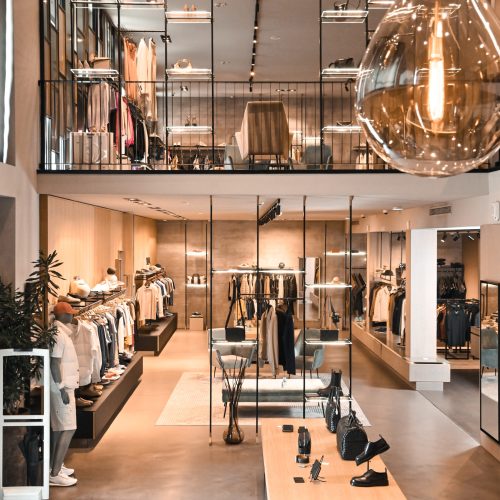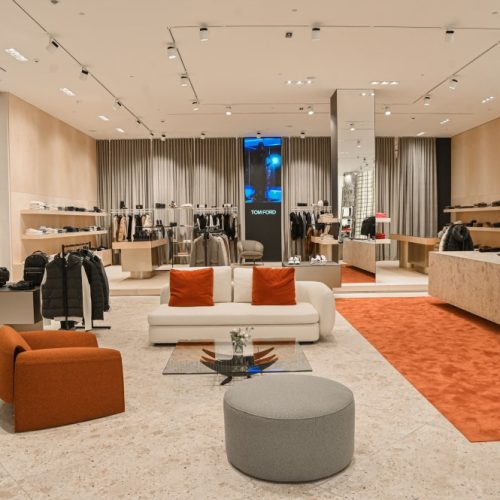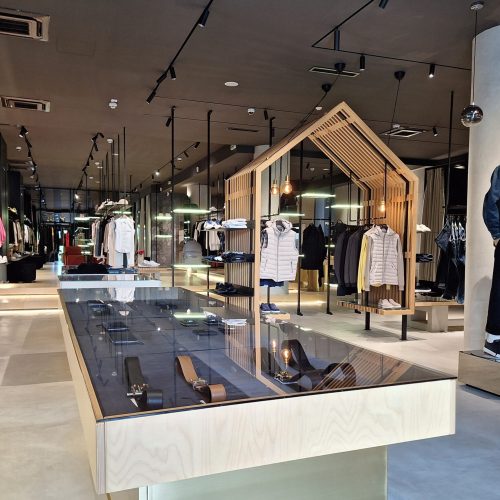The French Revolution swept away from the European fashion scene the opulent, aristocratic men’s fashion of the 18th century. Bright colors, embroidery, lace, jabots, and cuffs made way for a new, elegant, and simplified men’s suit of the 19th century. The suit evolved from the clothing worn by the English aristocracy, who spent a lot of time living and hunting on their country estates, requiring appropriate, more practical clothing. Consequently, England, which had positioned itself as the center of European men’s fashion in the 18th century, retained this status in the following period, with Italy joining in from the mid-20th century.
The men’s suit of the 19th century reflected not only the new, modern values of bourgeois society but also set the standards for classical masculine elegance that persist to this day – supreme tailoring, the appropriate choice of shapes, colors, and high-quality fabrics for specific occasions. Changes in men’s fashion, unlike the dynamic shifts in women’s fashion silhouettes, can be traced through various subtle details – the length and cut of the jacket, the method of fastening, the number and arrangement of buttons, the shape and dimensions of lapels and collars, the number and arrangement of pockets, and the cut of trousers.
This shift in men’s fashion also occurred in Serbia during the 19th century, where the European men’s suit replaced the colorful dress of the previous epoch, the layered Ottoman-Balkan urban dress of vibrant colors, richly adorned with embroidery and passementerie. Since the 1840s, numerous tailors’ advertisements have appeared in the Serbian press. In the late 19th and early 20th centuries, renowned tailors such as Marko Petronijević, Lazarević and Jovanović, as well as Sudarević and Savković, worked in Belgrade. Thanks to the supreme quality of their products and a large number of clients, their work can be tracked through press advertisements over an extended period.
Marko Petronijević, a tailor born in Obrenovac, opened his shop on Kneza Mihaila Street in 1881. His concise and well-balanced advertisements, sometimes published in French, indicate that he and his clients valued expert tailoring and a wide selection of high-quality fabrics with up-to-date fashion patterns from England and France. Trifun Jovanović, born in Vranje, was an apprentice with Marko Petronijević, subsequently worked in Germany, and completed a tailoring school in Vienna.
At the end of the 19th century, tailor-made clothes for women came into fashion – women’s suits designed along the same lines and from the same materials as men’s suits. Such clothes, tailored to the needs of modern lifestyle and a variety of outdoor activities, soon became available in Belgrade tailor shops. The Belgrade tailor Života Lazarević, who had been involved with the greatest and the most modern tailoring workshops in Vienna, Berlin, Paris, London, and St Petersburg for many years, opened his shop in 1902 at the corner of Balkanska and Kraljice Natalije streets. He announced in Mali žurnal magazine that besides men’s suits made to the latest patterns and finest fabrics, he had mastered the making of the most fashionable women’s suits, the so-called ‘Genre Tailleur’
In 1903, Života Lazarević and Trifun Jovanović co-founded the tailor shop Lazarević and Jovanović on Kneza Mihaila Street. The Museum of Applied Art holds a dinner jacket and a dinner suit made at this tailor shop in the interwar period, which show the highest standards in the production of men’s suits, for which the shop was famous. In 1923, Lazarević and Jovanović crowned their business success with the construction of the renowned hotel Splendid in Belgrade, the building which is still standing near the City Assembly of Belgrade.
Between the two World Wars, a significant place among Belgrade trendsetters was held by the tailor shop Sudarević and Savković. It was located on Topličin Venac, in the Čelebonović Palace, which now houses the Museum of Applied Arts. The museum collection holds a tailcoat suit and two jackets (tailcoat and dinner jacket) made in the shop. Nikola Sudarević, in addition to being a master tailor, was also involved in music. In addition to composing choral songs and a liturgy that was performed in Šabac, he sang in the choir of the Belgrade Opera for a long time. Sudarević was elected as a member of the examination board for master’s exams in the Tailors Section of the Craftsmen’s Association. Reflecting in 1929 on Sudarević’s penchant for music, a journalist of Nedeljne Ilustracije magazine concluded that he was an artist in tailoring and an amateur musician, which demonstrates that the tailoring craft is an art and that we are not behind Paris because we have great tailors who are also artists.
Draginja Maskareli
Museum advisor – Art and Fashion Historian
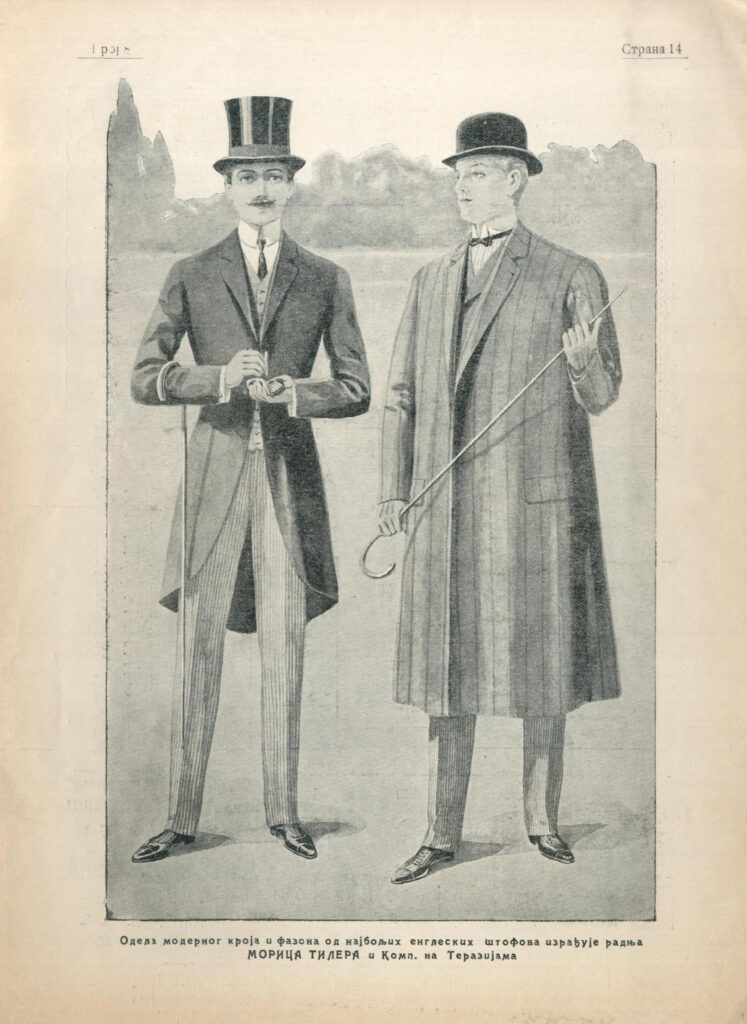
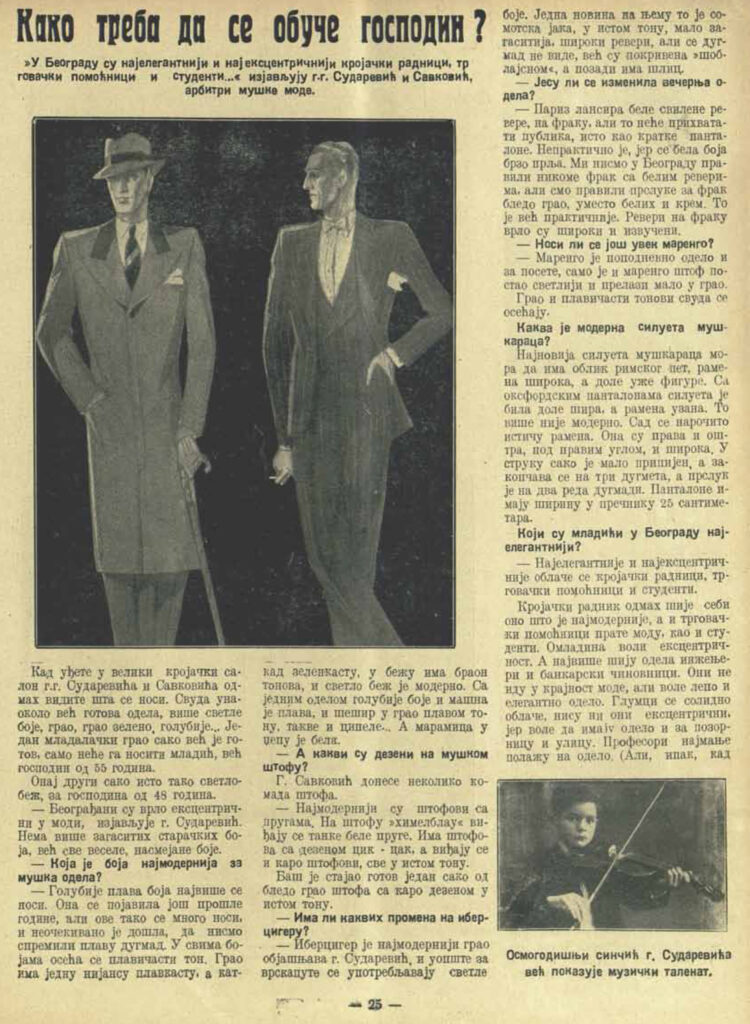



1. Fashion Illustration, Nedelja: ilustrovani sedmični zabavnik, Belgrade, February 28, 1910.
2. Men’s and Women’s Fashion in Belgrade (laying the foundation stone of the Funds Administration building, today’s National Museum of Serbia), Belgrade, April 13, 1903, photo: Wikimedia Commons / CC BY-SA 3.0 / Historical Archives of Belgrade
3. Advertisement of the tailor Marko Petronijević, Trgovačko-zanatlijski šematizam Kraljevine Srbije, Belgrade, 1905
4. Advertisement of the tailor Života Lazarević, Mali žurnal, Belgrade, August 14, 1902
5. Kako treba da se obuče gospodin? (How Should a Gentleman Dress?), an interview with the tailor Nikola Sudarević, Nedeljne Ilustracije, Belgrade, April 28, 1929

